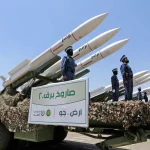Vladislav SHVED (Russia)
The Cold War transformed former allies in the anti-Nazi coalition—the United States and the USSR—into enemies. The Americans assigned their intelligence services to carry out political and psychological operations in the Soviet Union. In March 1948 that effort resulted in a secret document entitled “Use of Refugees from the Soviet Union in the US National Interest.”
Holding a grudge
On the eve of the 65th anniversary of the Great Victory, many kind words were said about our allies in the anti-Nazi coalition: the United States of America and Great Britain. It was all true, but we should not forget that relations between the Allies had a dark side. We know that in Québec on August 20, 1943, Franklin Roosevelt and Winston Churchill, leaders of the United States and Great Britain, met with the American and British Chiefs of Staff to discuss how the Germans could hold the Russians back as far as possible in the East.
Two plans were adopted at this meeting: OVERLORD, under which the Allies would launch an attack in France in 1944 (the Allied leaders informed the USSR about this plan in the November-December timeframe of 1943 in Tehran); and a second, top-secret plan called RANKIN. The purpose of RANKIN was to turn the entire might of an undefeated Germany against Russia. In April 1945, in order to develop RANKIN Churchill gave the English forces an order: prepare Operation Unthinkable.
The essence of that operation was that on July 1, 1945 British, American, and Canadian forces, together with the Polish Corps and 10 to 12 German divisions that had not been disarmed, were to begin military actions against the Soviet Union.
This plan was prevented by the crushing blows inflicted by the Red Army on Nazi Germany at the end of the war. The “Allies” calculated their chances of success and understood that within a week after beginning Operation Unthinkable Soviet tanks would reach the Atlantic Ocean and seize control of all Europe.
However, after the United States developed atomic weapons, plans for attacking Soviet territory were revived. Recall that starting in late 1945 the military leadership of the United States annually submitted ever more grandiose schemes for bombing the USSR with nuclear weapons.
However, the Americans remembered that the enormous damage inflicted by Nazi German bombers on the Soviet Union and the total destruction of its infrastructure could not weaken its economic power and break the spirit of the Soviet people. Therefore, the leadership of the US Air Force decided to determine the ultimate strength of the Soviet people in the event of a massive atomic bombardment. The following development helped the Americans solve that problem.
World War II gave rise to a movement of peoples that was unprecedented in human history. By May 1945, the number of refugees in Europe exceeded 40 million people. The Nazis had forcefully evacuated many of them to Germany to serve as a labor force (in January 1944 that force amounted to more than 8 million people). A considerable number of them were Soviet citizens. Their repatriation to the USSR under the Yalta Agreement began in late May 1945. Most Soviet citizens returned to their homeland willingly. However, there were those who did not want to leave Europe. These “non-returnees” had a variety of reasons for wanting to stay. For one thing, war criminals and Nazi collaborators could not count on a warm welcome in the Soviet Union. However, there were quite a few who did not accept the Soviet system with its numerous limitations and suppression of individuality.
It is believed that by June 1947 there were approximately 250 thousand Soviet non-returnees in Western Europe. Many of them were located in the American occupation zone. They were selected for sociological studies by American experts.
As already mentioned, the US Air Force, which initially funded the Harvard Project, established a narrow objective—interview the non-returnees to assess the psychological vulnerability of the Soviet civilian population during a massive atomic bombardment. But during the Cold War the project soon outgrew its original aim.
The Harvard Project to utilize Soviet refugees was initiated by John Paton Davies, a member of the political planning group at the US State Department headed by the well-known Sovietologist and former Ambassador to the USSR, George Kennan. In the early 1950s, American experts were able to process refugees in 67 camps and in several German cities, administering more than 13 thousand oral interviews and written questionnaires. This process gave American scientists the basis for drawing conclusions that shocked American politicians.
They found that the antagonism Soviet refugees felt toward the Soviet system did not mean that they rejected literally everything about it. It turned out that the discontent of Soviet non-returnees was due less to the Soviet political system itself than to the country’s Communist leadership. In responding to a question about what they would retain from the Soviet system should the regime fall, literally everyone identified education as their top priority, followed by health care and social security for the populace.
Moreover, the non-returnees were proud of the successes achieved by industrialization and the position occupied by the Soviet Union on the international stage. Most welcomed the regime’s sense of purpose, its energy and its confidence in the country’s future.
They stressed the Soviet Union’s very significant cultural achievements. The positive assessment by former Soviets of the role played by the state in the country’s economy was a revelation for the Harvard researchers.
They identified numerous negative features of the Soviet system, including excessive bureaucracy and poor planning; however, the former Soviets were generally convinced that a welfare state could not be established on a private enterprise basis. About two-thirds of respondents were in favor of state planning and state ownership in the economy. Bear in mind that this was the opinion of people who were dissatisfied with the Soviet system and were unwilling to return to the USSR.
More details about the Harvard Project and its recent development can be found in the book by Professor Yevgeny Kodin, Doctor of Historical Sciences, “The Harvard Project,” [Garvardskiy proyekt] (Moscow: Russian Political Encyclopedia, 2003). The article by Arkady Medvedev, “The Harvard Project: A Half Century Later” (Soyuz. Belarus’-Rossiya, Sept. 4, 2003, No. 35/135), also contains much that is interesting.
Birth of the “puppet masters”
In order to conduct an information and psychological war, it was necessary to develop effective psychological technologies for influencing the Soviet people. During World War II Nazi specialists from the office of Alfred Rosenberg were engaged in doing this. Rosenberg was an immigrant from the Baltic and an “expert” on the Oriental soul. Experts in the Harvard Project carried on the work after the war. As already mentioned, the work was based on polls of former Soviet citizens.
That was the genesis of the famous Harvard Project on the Soviet social system—one of the most ambitious political-sociological studies conducted on Soviet society. It was carried out by the Center for Russian Studies, which was specially established at Harvard University in 1948.
The project used two types of surveys: biographical (A-Schedule interviews), which gathered general sociological data, and specialized (B-Schedule interviews). The latter collected “socio-anthropological” data on economics, family relations, social stratification, power relations, etc.
The specialized surveys focused on identifying, collating and grouping personal and psychophysical characteristics of people, especially those characteristics that make a person of leader in a group and in society. To accomplish this, American intelligence gave the experts involved in the Harvard Project an enormous amount of material on the personal characteristics of distinguished world political figures and giants of science, technology and culture. Particular attention was devoted to the study of Lenin’s personality in order to identify the psychophysical qualities of the “leader complex.”
Professor Novikov at Stratford University notes that hundreds of Soviet refugees were subjected to special psychological studies during the course of this project. The interviews involved Rorschach tests, which make use of ink blots, and tests involving incomplete sentences; and they included interviews on sexual topics where every word was recorded on tape. Other tests were also administered, in which psychoanalysis was used to identify various psychological complexes. Oddly enough, one such complex identified by the Harvard experts was called a “Lenin complex.”
It was found that the majority of world leaders had a pronounced innate authority complex. People with this complex usually win a power struggle, especially if they do not follow generally accepted standards of morality. If they are assisted by a well organized group of specialists (so-called puppet masters) equipped with the knowledge of human psychology gained in the Harvard Project, their opponents simply have no chance of winning.
Today, we can say with complete certainty that a professional group of “puppet masters” is able to identify and move future leaders into positions of power like pawns in an international game of chess.
A former member of the Harvard Project, Soviet defector Grigory Petrovich Klimov (Igor Borisovich Kalmykov) wrote about this in his shocking book “God’s Chosen People” [Bozhiy narod]: “Any well organized group of people armed with knowledge of this taboo topic can identify and move future leaders into positions of power like pawns in an international game of chess. It goes without saying that leaders of the degenerate sect who possess firsthand knowledge of the subject and have already been playing this game for thousands of years enjoy a tremendous advantage over those who are playing without that knowledge, without preparation, and blindfolded to boot.”
Although many of Klimov’s conclusions are controversial and some are totally unacceptable, his assertion that such leaders can be as effective as weapons of mass destruction is valid. For the Soviet Union, their effectiveness turned out to be even greater.
The presidential elections that brought Saakashvili, Yushchenko and others to power are examples of puppet master successes in the post-Soviet space.
In the early 1970s, I had the opportunity to observe use of the American test techniques in identifying the leaders among first-year cadets at the Vilnius Higher Military-Technical Institute of Radio Electronics. More than 80% of the test results were confirmed within three years.
An important outcome of the Harvard Project was the development of techniques for controlling both different population groups and individuals. The American film “The Game” starring Michael Douglas illustrates a classic example of an effective tactic used by puppet masters to manipulate an individual. Circumstances created by a group of organizers and psychologists forced the film’s protagonist to attempt suicide. But all ends happily when the hero learns it was a game intended to help him learn to enjoy life again.
No doubt puppet masters who possess the techniques and knowledge of human psychology are not only capable of moving future leaders into positions of power, they can create desired socio-political situations, as well. However, practice has shown that knowledge and anticipation of the main techniques employed by Western puppet masters can in many cases enable people to successfully resist them. Therefore, we should not consider the Harvard techniques to be absolutely infallible and super effective.
Unfortunately, the dogmatic confidence of the top Soviet political leadership in the “overwhelming power of Marxist-Leninist doctrine” prevented us from countering those techniques when they became widely used against the USSR.
We should recognize that the collapse of socialist values and ideals was largely caused by the West’s employment of information-psychological warfare methods from the Harvard Project. The results were largely determined by the forms and methods used by Western intelligence services and media to influence Soviet citizens. This can be most clearly seen in the radio broadcasts to the Soviet Baltic states, especially to Lithuania. Secret monitoring of public opinion done systematically in Lithuania by Western experts after the war made it possible for Western radio stations to swiftly change the tenor of their broadcasts.
Before the 1960s, broadcasters on Radio Free Europe and Voice of America urged Lithuanians to oppose Soviet power and wait for the combined forces of the West to liberate the Baltic countries. But their tone changed in the middle 1960s. People were advised to join the Komsomol and the Party, attend institutions of higher learning, work hard, reach high positions in Soviet society and attain positions of leadership.
Valery P., who was deputy director of the propaganda department in the Central Committee of Lithuania’s Komsomol, studied this issue in the early 1970s. His research on the topics and the focus of the broadcasts by Western radio stations to Lithuania was impressive. The strategy of our main ideological enemy, the United States, had changed, not its tactics. P. took his materials to the Central Committee of Lithuania’s Communist Party. However, after studying them they said that his results were of no particular interest and suggested that he stop following the subject.
As we later learned, the explanation was simple. A large portion of the Lithuanian intellectual elite that had moved into high-level Party and management positions in the 1960s and 1970s came under a cloud for not recognizing the importance of P.’s research.
Will Harvard survive?!
The main reason USSR lost the West’s psychowar against was the failure of the Kremlin leadership to improve the welfare and living standards of the Russian people as a state-forming nation in the broad sense of the term. After living a half-century in Lithuania, I traveled through many regions of Russia between 1996 and 2000 and was struck by the disintegration and poverty I saw. The previous 10 years of perestroika and the collapse of the USSR had taken their toll of course, but the standard of living of the Russian people in 1985 was significantly lower than that of the Baltic republics. It is not surprising that when Lithuanians argued with Russians they usually said: “Why are you telling us how to live? First learn how to live like human beings!”
Turkmenistan President Saparmurat Niyazov had this to say about life in Central Russia during an interview in the 1990s: “The Russian people aren’t to blame for what is happening today. It was the system. I visited Russian villages while I was working in the CPSU Central Committee, and in 1984 I oversaw the Kursk and Belgorod regions (Central Russia). Even then peasants were drinking themselves to death in the villages. And that was in Russia’s heartland! The region didn’t get rich while it was part of the USSR; it didn’t line its pockets at anyone’s expense. And who could they take advantage of anyway? In Indonesia Khrushchev built a stadium for 100 thousand spectators, and we couldn’t get a simple children’s playground. Heavy-duty trucks were sent to the Congo, but here we used donkeys and camels to transport oil. That’s our shared past, but we don’t have hard feelings towards anyone, much less Russia.”
The Harvard Project did not disappear when the Cold War ended. In August 1997, the Harvard Institute informed the Russian public about development of a New Harvard Project through the Russian daily newspaper Nezavisimaya Gazeta. At the time, a number of Russian analysts rushed to the aid of the Harvard experts. However, their advice appeared to be unprofessional.
That is probably why we have recently begun seeing information about establishment of the new Houston Project. It is a logical extension of the Harvard Project, but focused on present-day Russia.
However, it is premature to suppose that the techniques of the Harvard-Houston Project in the United States and present-day Russia have been put on the back burner. The large piece of the world’s pie that is Russia will always be coveted by Western transnational corporations and states. And in order for them to consume the pie in comfort, Russia must be weak, fragmented and incapable of following an independent policy. Therefore, the Harvard information-psychological techniques for influencing Russians will remain in the arsenal of our “good Western friends” for a long time to come.
To understand how true this is, we need only analyze the psychological focus of both the Western media and the Russian media. When it comes to falsifying Russia’s historical path, the “Harvard spirit” can be felt a mile away. Nonetheless, the Harvard wolf is not as frightening as depicted by some Russian commentators, provided Russians do not forget that they live in a world of vultures and avoid repeating past mistakes.
Vladislav Shved is an author of the Russian analytical site Stoletie.ru
Source: New Eastern Outlook














Comments